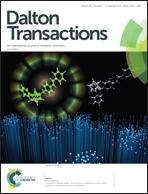Replacing C6F5 groups with Cl and H atoms in frustrated Lewis pairs: H2 additions and catalytic hydrogenations†
Abstract
2-(Dialkylamino)phenylboranes containing the BXZ group, where X, Z = C6F5, Cl, and H, were prepared in a few synthetic steps and demonstrated the cleavage of H2 under mild conditions. Depending on the nature of the dialkylamino group, X, and Z, the stability of the produced zwitterionic H2 adducts varies from isolated solids indefinitely stable in an inert atmosphere to those quickly equilibrating with the initial aminoborane and H2. Using a combined experimental/computational approach on a series of isostructural aminoboranes (dialkylamino = 2,2,6,6-tetramethylpiperid-1-yl), it was demonstrated that the electronegativity and the steric effect of the substituents generally follow the trend C6F5 ∼ Cl ≫ H. This observation is useful for designing new FLPs for practical applications. As an example, we demonstrated the hydrogenation of alkynes to cis-alkenes under mild conditions that was catalyzed by a chloro-analogue of the C6F5-substituted aminoborane developed previously. The presence of a BHCl group in the aminochloroboranes or in their H2 adducts features facile redistribution of the H and Cl atoms and the formation of polychloro and polyhydrido species.



 Please wait while we load your content...
Please wait while we load your content...